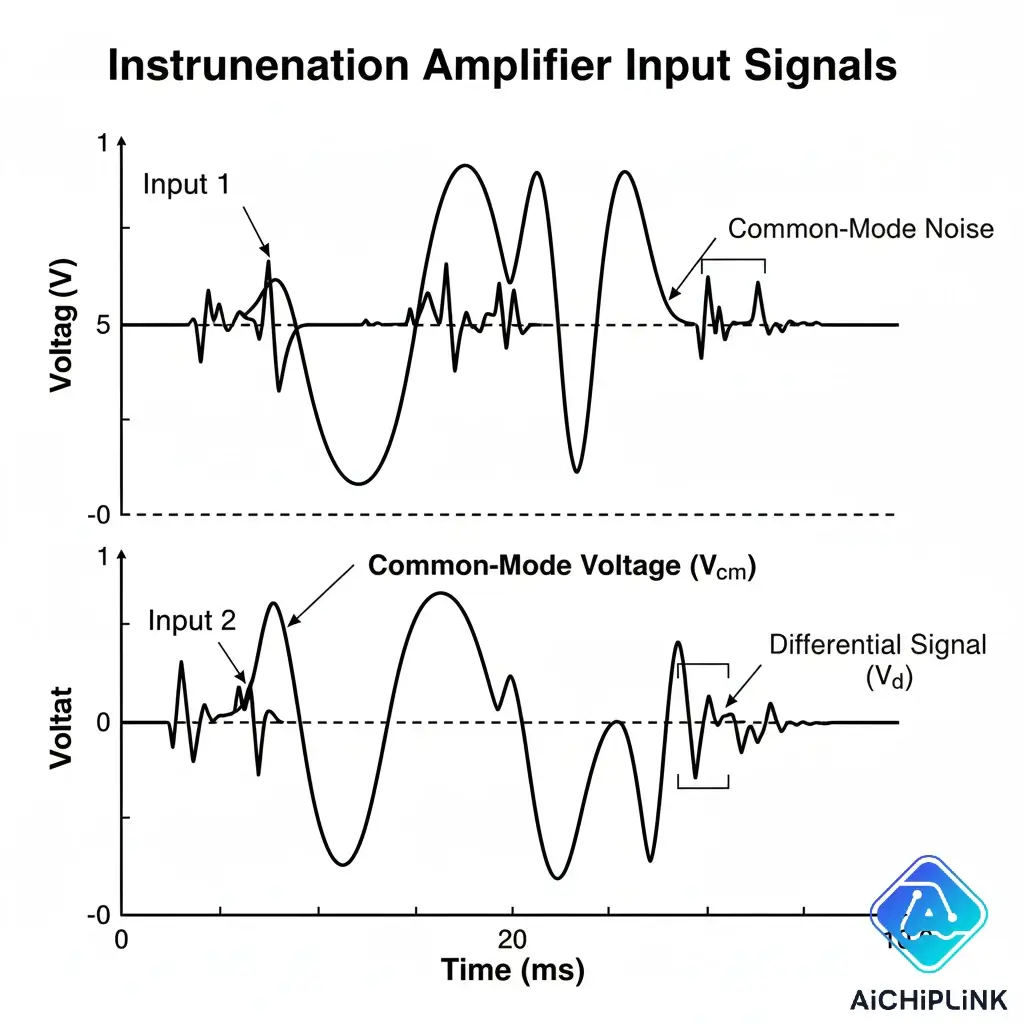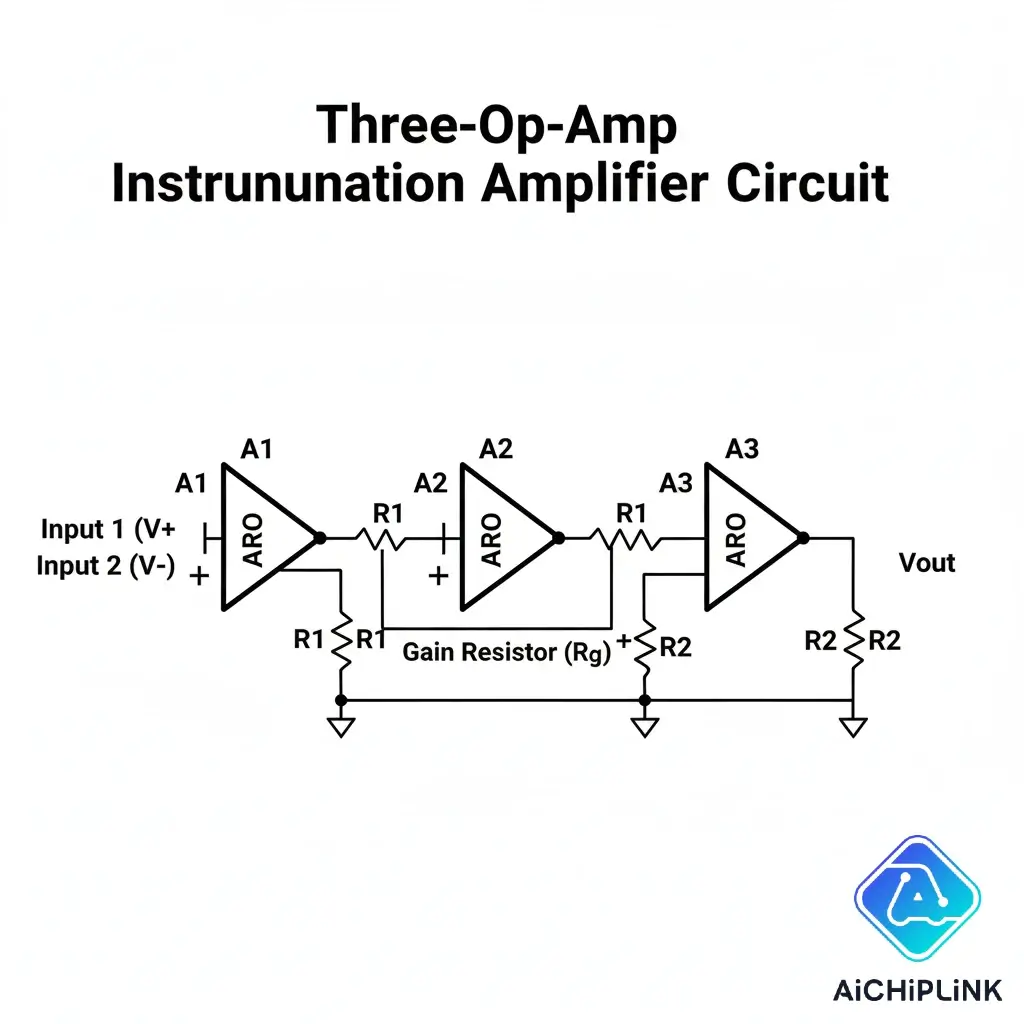
Table of Contents
- 1.0 What is an Instrumentation Amplifier (and Why Isn't It Just a Fancy Op-Amp)?
- 2.0 The INA Superpower: Understanding Common-Mode Rejection Ratio (CMRR)
- 3.0 How an Instrumentation Amplifier Works: The Three-Op-Amp Configuration
- 4.0 Key Applications and How to Choose an INA
Imagine trying to hear a whisper in the middle of a rock concert. The whisper is the tiny, important signal you need to measure, and the concert is the overwhelming electrical noise present in almost every real-world environment. If you use a standard amplifier (like a simple op-amp), you'll just make the concert louder, and the whisper will still be lost. This is the exact problem faced by engineers working with precision sensors. The solution is a specialized type of amplifier designed to be the ultimate signal listener: the Instrumentation Amplifier, often abbreviated as INA or in-amp.
An instrumentation amplifier is not just another op-amp; it's a precision instrument in its own right. With the rapid growth of industrial automation and medical diagnostics, the need to extract clean, reliable data from sensors has never been more critical. This guide will demystify the instrumentation amplifier, explain its noise-canceling superpower (CMRR), and show you why it's the go-to choice for high-precision measurement.
1.0 What is an Instrumentation Amplifier (and Why Isn't It Just a Fancy Op-Amp)?
An instrumentation amplifier is a type of differential amplifier that has been optimized for use in measurement and test equipment. It is designed to have high input impedance, a high common-mode rejection ratio (CMRR), and an easily adjustable gain.
1.1 The Core Purpose: Amplifying Tiny Differential Signals
The primary job of an INA is to extract a small differential voltage and amplify it. A differential voltage is the voltage difference between two points. Many sensors, like strain gauges and thermocouples, produce their signal as a tiny change in differential voltage. The INA is designed to amplify only this difference, while ignoring any voltage that is common to both points.
1.2 Instrumentation Amplifier vs. Operational Amplifier: The Key Differences
While you can build a differential amplifier with a standard op-amp, it will have serious limitations that the INA is specifically designed to overcome.
| Feature | Standard Op-Amp (Difference Amp) | Instrumentation Amplifier (INA) |
|---|---|---|
| Input Impedance | Relatively low and unbalanced. Can "load" the signal source. | Extremely high and balanced. Does not load the source. |
| CMRR | Moderate. Highly dependent on perfectly matched external resistors. | Extremely high. Internal, laser-trimmed resistors ensure high performance. |
| Gain Setting | Requires changing multiple, precisely matched resistors. | Set with a single external resistor. Gain is accurate and easy to adjust. |
| Ease of Use | Requires careful component selection and layout. | A single, integrated component that is easy to implement. |
2.0 The INA Superpower: Understanding Common-Mode Rejection Ratio (CMRR)
The single most important specification of an instrumentation amplifier is its Common-Mode Rejection Ratio (CMRR). This is the metric that defines its noise-canceling ability.
2.1 Differential Signals vs. Common-Mode Noise Explained
- Differential Signal: This is the actual signal of interest—the tiny voltage difference between the two input wires from your sensor.
- Common-Mode Signal (Noise): This is any unwanted voltage that appears identically on both input wires. The most common source is 50/60Hz hum picked up from nearby power lines.

2.2 Why a High CMRR is Critical for Real-World Measurements
CMRR is a measure of how well the amplifier rejects the common-mode noise while amplifying the differential signal. An INA with a high CMRR can have a large noise signal at its inputs and produce a clean, amplified version of only the tiny differential signal at its output. This is precisely how it "hears the whisper in the rock concert." As explained in detailed tutorials from experts at Analog Devices, high CMRR is the key to precision measurement.
"A standard op-amp might reject 99% of common-mode noise. That sounds good, but for a precision measurement, it's not enough. A good instrumentation amplifier can reject 99.999% of the noise, making it a thousand times more effective."
3.0 How an Instrumentation Amplifier Works: The Three-Op-Amp Configuration
While modern INAs are monolithic integrated circuits, most are based on the classic three-op-amp topology, which cleverly achieves all the desired characteristics.
3.1 A Look Inside the Classic INA Circuit
The circuit consists of three main parts:
- Input Buffers (A1 & A2): The two input signals are fed into two separate op-amps configured as non-inverting buffers. This provides the extremely high and balanced input impedance and prevents loading of the source. This stage also provides the differential gain.
- Difference Amplifier (A3): The outputs from the two buffer stages are then fed into a standard difference amplifier. This stage is responsible for subtracting the two signals, which removes the common-mode noise.
- Gain Resistor (Rg): A single resistor placed between the first two op-amps.

3.2 The Role of the Gain Resistor (Rg)
One of the most elegant features of this design is that the differential gain of the entire amplifier can be set by the value of a single external resistor, Rg. The gain is inversely proportional to Rg; a smaller resistor gives a higher gain. This makes it incredibly easy to adjust the amplification for different sensors and applications without needing to worry about matching multiple resistors.
4.0 Key Applications and How to Choose an INA
Instrumentation amplifiers are the go-to solution for any application that requires the precise measurement of small differential signals.
4.1 The Perfect Partner: INAs and Wheatstone Bridge Sensors
The most common application for an INA is amplifying the signal from a Wheatstone bridge. Many sensors, such as strain gauges, load cells, and some pressure sensors, are configured in a bridge. When a physical force is applied, the bridge becomes slightly unbalanced, creating a very small differential output voltage that is directly proportional to the force. An INA is perfect for accurately measuring this tiny imbalance.
4.2 Other Common Applications (Medical ECG, Data Acquisition)
- Medical Instrumentation: Measuring biopotential signals like ECG (electrocardiogram) and EEG (electroencephalogram).
- Data Acquisition (DAQ) Systems: Capturing high-quality data from a wide range of sensors in industrial and laboratory settings.
- Thermocouple Amplifiers: Accurately measuring the tiny voltage produced by a thermocouple.
- Current Sensing: Measuring the voltage drop across a small shunt resistor to determine current flow.
4.3 Choosing the Right Instrumentation Amplifier IC
When selecting an instrumentation amplifier IC like the popular AD620, consider these factors:
- CMRR: Higher is better. Look for values of 80 dB or more.
- Input Offset Voltage: A lower offset voltage means better accuracy for DC signals.
- Bandwidth: Must be wide enough to handle the frequency of your signal.
- Gain Range: Ensure the IC can provide the gain you need with a practical value for Rg.
- Power Supply: Does it require a dual (+/-) supply, or can it run from a single supply?
The instrumentation amplifier is a masterpiece of analog circuit design. It solves one of the most common and difficult problems in electronics: accurately measuring a small signal in a noisy environment. By combining high input impedance, easily adjustable gain, and its superpower—an exceptionally high common-mode rejection ratio—the INA provides a complete, robust solution in a single package. For any application that demands precision and reliability in sensor measurement, the instrumentation amplifier is not just a good choice; it's the essential one.
Ready to make precision measurements? Explore our selection of high-performance instrumentation amplifiers and related analog components at aichiplink.com today!

Written by Jack Elliott from AIChipLink.
AIChipLink, one of the fastest-growing global independent electronic components distributors in the world, offers millions of products from thousands of manufacturers, and many of our in-stock parts is available to ship same day.
We mainly source and distribute integrated circuit (IC) products of brands such as Broadcom, Microchip, Texas Instruments, Infineon, NXP, Analog Devices, Qualcomm, Intel, etc., which are widely used in communication & network, telecom, industrial control, new energy and automotive electronics.
Empowered by AI, Linked to the Future. Get started on AIChipLink.com and submit your RFQ online today!
Frequently Asked Questions
What is the main difference between an op-amp and an instrumentation amplifier?
An op-amp is a general-purpose building block, while an instrumentation amplifier (INA) is a specialized circuit designed for precision differential signal amplification. The main difference is that an INA has high input impedance, high CMRR, and easily adjustable gain, all integrated into a single package.
What is CMRR in an instrumentation amplifier?
CMRR (Common-Mode Rejection Ratio) is a measure of how well the amplifier rejects noise that is common to both of its inputs. A high CMRR allows the INA to ignore large noise signals and only amplify the small sensor signal between its inputs.
Why do instrumentation amplifiers have three op-amps?
The classic three op-amp design provides high input impedance using two buffer op-amps on the input, and then uses a third op-amp as a difference amplifier to reject the common-mode noise. This configuration elegantly achieves the core requirements of an INA.
What is a difference amplifier?
A difference amplifier is a circuit that amplifies the difference between two input voltages. An instrumentation amplifier is a specific, high-performance type of difference amplifier with added features like very high input impedance.
Can an INA have a gain of 1?
Yes. By choosing a very large (or omitting) the gain resistor Rg, an INA can have a gain of 1. In this configuration, it acts as a high-precision differential buffer, which is useful for isolating a signal source without providing any amplification.














